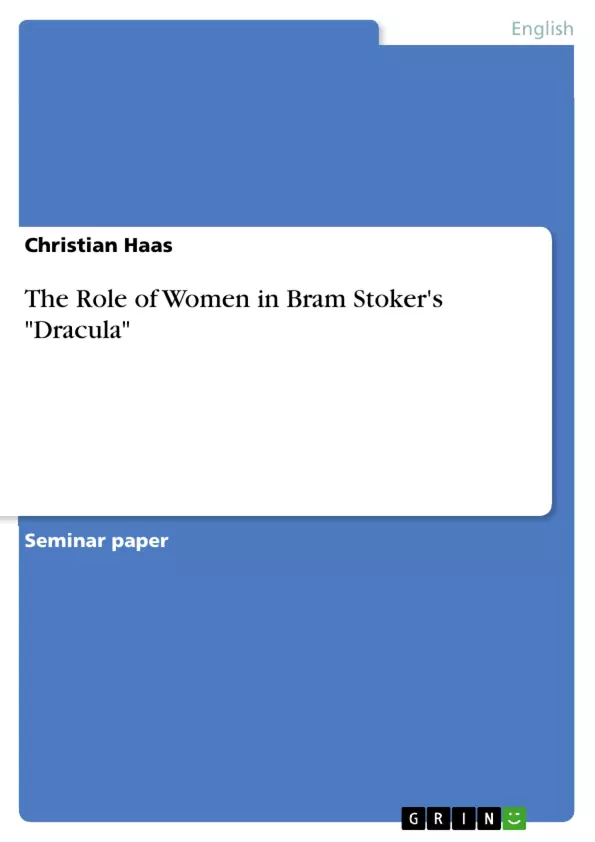Bram Stoker´s novel "Dracula" presents two different kinds of women of the Victorian era: Lucy Westenra and Mina Harker.
This era is characterised with the emerging ‘New Woman’ movement. Many critics persuade us, that Mina and Lucy embody paradigmatic representatives of the ‘New Women’ ideas and behaviour.
In this work the main characteristics to the female characters of the novel will be given, considering the reasons of their actions by contrasting their Victorian and ‘New Women’ features.
Table of Contents
- Introduction
- The role of women in the Victorian era
- The 'New Women' movement
- Images of women in Dracula
- Lucy Westenra
- Education and lifestyle
- Seduction of Lucy by Dracula
- Lucy as a vampire
- Mina Harker
- Mina as a caring wife
- Seduction of Mina by Dracula
- Thoughts of Mina on the modern woman
- Lucy Westenra
- Conclusion
Objectives and Key Themes
This work examines the portrayal of women in Bram Stoker's Dracula, contrasting the contrasting Victorian and "New Woman" ideas. It delves into the characters of Lucy Westenra and Mina Harker, exploring their actions and motivations within the context of Victorian society and the emerging "New Women" movement.
- The portrayal of women in Victorian society
- The "New Women" movement and its impact on women's roles
- Analysis of Lucy Westenra as a representation of Victorian ideals
- Examination of Mina Harker as a potential embodiment of "New Women" ideals
- The role of women in Bram Stoker's Dracula
Chapter Summaries
- Introduction: The introduction introduces the topic of women in Bram Stoker's Dracula and highlights the contrasting representation of Victorian and "New Women" ideals in the characters of Lucy Westenra and Mina Harker.
- The role of women in the Victorian era: This chapter explores the prevailing expectations and constraints placed upon women in Victorian society, including their limited opportunities, societal expectations of purity and chastity, and the power dynamics within marriage. The chapter delves into the limited opportunities for women to support themselves financially and their dependence on men. It highlights the concept of the "angel in the house" as an ideal for women and discusses prostitution as a contrasting reality.
- The 'New Women' movement: This chapter examines the emergence of the "New Women" movement in the 1860s as a response to the oppressive social and cultural structures of Victorian society. It discusses the challenges posed by "New Women" to traditional gender roles and expectations, their embrace of independence, their pursuit of education and professional careers, and their questioning of social conventions. The chapter includes examples of authors who explored these themes in their novels.
- Images of women in Dracula - Lucy Westenra: This chapter focuses on the character of Lucy Westenra, examining her upbringing, her desire for marriage and motherhood, and her eventual seduction by Dracula. The chapter explores whether Lucy embodies the Victorian ideal of womanhood and considers her relationships with her male suitors.
- Images of women in Dracula - Mina Harker: This chapter analyzes the character of Mina Harker, exploring her role as a caring wife and her eventual entanglement with Dracula. The chapter discusses Mina's potential as a representation of "New Women" ideals, considering her intelligence, agency, and active role in the narrative.
Keywords
Key themes and keywords of the text include the portrayal of women in Victorian society, the "New Women" movement, the analysis of the characters of Lucy Westenra and Mina Harker, the novel Dracula by Bram Stoker, Victorian social norms, female agency, and the interplay between Victorian and modern ideals.
- Quote paper
- Christian Haas (Author), 2014, The Role of Women in Bram Stoker's "Dracula", Munich, GRIN Verlag, https://www.grin.com/document/292909



